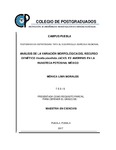Análisis de la variación morfológica del recurso genético Vanilla planifolia Jacks ex Andrews en la Huasteca potosina, México.
Abstract
Vanilla planifolia es una de las especies más valiosas del mundo, por lo que conocer su variación es muy importante. El tema central de esta investigación residió en estudiar la variación morfológica de esta especie, en la Huasteca potosina, México. Por lo que se propuso conocer si los gradientes ambientales y su distribución, influyen en su variación infraespecífica; identificar su variación morfológica, y determinar su nivel de manejo en la región. El análisis de la distribución espacial consistió en ubicar y georreferenciar sus poblaciones, y determinar las variables abióticas para ser procesadas con Sistemas de Información Geográfica, análisis de clúster y el programa Maxent. Su caracterización morfométrica comprendió la evaluación de 679 labelos, a través del trazado y medición de 76 variables, por medio de un análisis de varianza, prueba de medias y análisis multivariado, con el paquete estadístico SAS. La documentación del manejo se basó en 15 entrevistas semiestructuradas, que se interpretaron conforme a un análisis descriptivo. Se ubicaron 40 poblaciones de V. planifolia, distribuidas en cinco tipos de ambientes, a lo largo de nueve municipios de la Huasteca potosina. Sus gradientes estuvieron determinados por el régimen de humedad del suelo, altitud y clima. Su distribución potencial abarcó 13 municipios, con nichos idóneos en los municipios de Aquismón, Axtla de Terrazas, Coxcatlán, Huehuetlán, Matlapa, Tamazunchale, Tancanhuitz de Santos y Xilitla. La precipitación del mes más seco, el régimen de humedad del suelo y la precipitación del trimestre más seco determinaron su distribución geográfica. Esta especie presentó cinco morfotipos, con formas redondeadas, globulares y alargadas, que se diferenciaron por los lóbulos basales, apicales y ángulos internos del labelo. Se identificaron cinco etapas de manejo in situ en la Huasteca potosina. Se encontró variación morfológica, y tanto los gradientes ambientales como la intensidad de manejo no influyeron en esta, por lo que es posible que su variación sea genética. _______________ MORPHOLOGICAL VARIATION ANALYSIS OF Vanilla planifolia JACKS. EX ANDREWS IN THE REGION OF THE HUASTECA POTOSINA, MEXICO. ABSTRACT: Vanilla planifolia is one of the most valuable species of the world, so know its variation is very important. The aim main of this research was to study the morphological variation of this specie, in the Huasteca Potosina, México. Therefore it was suggested to know if the environmental gradients and its distribution, affect its infraspecific variation; identify its morphology variation, and to determine its level of management in the region. The analysis of the spatial distribution was to locate and to georeference its populations, and to determine the abiotic variables to be processed with Geographical Information Systems, cluster analysis and the Maxent program. Morphometric characterization was evaluated 679 labels, through the drawing and measurement of 76 variables of the lip, by means of an analysis of variance, Tukey test and multivariate analysis with the statistical package SAS. The research of the management was based on 15 semi-structured interviews, which were interpreted according to a descriptive analysis. A total of 40 populations of V. planifolia was distributed in five types of environments, it was located along nine municipalities of the Huastec Potosina region. Its gradients were determined by the soil moisture regime, altitude and climate. Potential distribution consisted of 13 municipalities, with suitable niches in Aquismón, Axtla de Terrazas, Coxcatlán, Huehuetlán, Matlapa, Tamazunchale, Tancanhuitz de Santos and Xilitla. The precipitation of the driest month, soil moisture regime and rainfall in the driest quarter determined its geographical distribution. This species presented five morphotypes, with rounded, globular and elongated forms, which were differentiated by the basal lobes, apical and internal angles of the lip. Five management stages in situ were identified in the Huasteca Potosina. A morphological variation was found, and both environmental gradients and the management intensity did not influence it, so it is possible that their variations is genetic.
Collections
- Tesis MC, MT, MP y DC [398]


